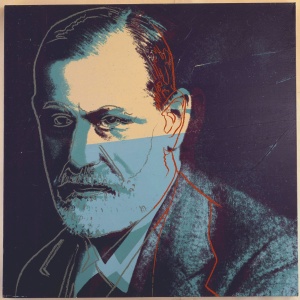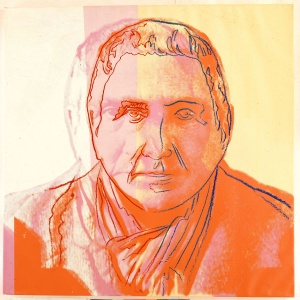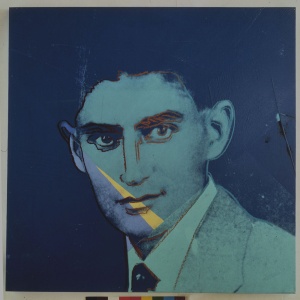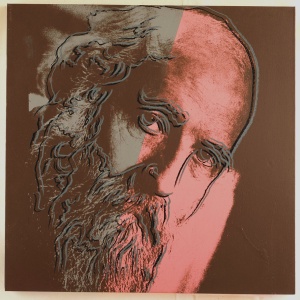Ten Portraits Reconsidered
When an artist creates, intention, elementary to the creative process, is paradoxically secondary to the finished work. Once the art work is on view in the larger world it must stand on its own, engaging the audience on its aesthetic merits and creating a meaningful dialogue by means of its content and subject matter.
The artist’s intention becomes a historical footnote, a peripheral fact that may or may not relate to how and what the artwork has to say. The artist’s job is over now and the artwork takes on a life of its own.
Therefore it is quite beside the point that when Andy Warhol created Ten Portraits of Jews of the Twentieth Century (1980), now at the Jewish Museum, his primary goal was to make as much money as possible on this project. Initially he made an edition of 200 silkscreen prints, quickly followed by five sets of 10 acrylic paintings, all using the exact same images and line drawings for each of his “Jewish Geniuses,” only varying the colors.
Equally immaterial is the fact that the original idea for this project came not from the artist but from his dealer Ronald Feldman. Additionally, the actual choice of the individual Jews was directed by Feldman with help from Israeli art dealer Alexander Harari and Susan Morgenstein (director of JCC of Greater Washington), who provided the relevant biographical details about each individual. Warhol was shown hundreds of vintage photos and copious background information on each to finally choose ten famous Jews to depict. He choose Sarah Bernhardt, Louis Brandeis, Martin Buber, Albert Einstein, Sigmund Freud, the Marx Brothers, Golda Meir, George Gershwin, Franz Kafka, and Gertrude Stein. When asked exactly why he choose these particular ten, Warhol responded, “Because I liked the faces.” Evidently not because of the role they played as Jews in the 20th century. Just nice images.
At first glance the images are big (40” x 40” paintings), brash, commercial and superficial. They all begin with a black and white photograph enlarged into a transparency. A line drawing was done over the image by Warhol and then a collage of transparent colored paper was assembled over the image. Finally silkscreen prints were made. The same image and drawing was silkscreened over an arbitrarily textured canvas as the foundation of the acrylic painting. The technique and style flows directly from Andy Warhol’s early years as a commercial artist with more than a hint of Matisse’s colorful late cutouts.
Warhol had gained notoriety as one of the founders of Pop art in the early 1960’s with a series of paintings of “Campbell’s Soup Cans” and paintings of celebrities such as Marilyn Monroe and Elizabeth Taylor, developing a style that depicted mass-produced products in a technique of mass production, i.e. silkscreen.
His celebration of popular culture, fame and commercialism scandalized much of the art world by attacking modernist icons of originality and self-expression. Many years later his work would be characterized as an early expression of Postmodernism, an approach to art and culture that delights in deconstructing the normative, reveling in the ironic and, seemingly whimsical, finally refusing to take a principled stand on almost anything.
Warhol quickly became wildly popular, featured at the Whitney Museum and in countless major collections. Between 1972 and his death at 58 in 1987 he produced hundreds of commissioned portraits of the rich and famous, the glitterati, socialites and celebrities in the same technique he used for the Ten Jews. Additionally much of his work feted the underground, low-life culture rampant on the fringes of 1970’s culture. What distinguished this series of “Ten Jews” was the nature of the subjects and reaction it engendered.
Warhol’s Jews were all no longer alive but had been serious cultural figures and, in what is the series most surprising aspect, overwhelmingly at the heart of profound social change. At the exact moment Warhol was engrossed in debunking the sacred cows of Modernism by celebrating the superficial, he made icons of the profound Jewish influence in 20th century culture and thought. The Jews responded enthusiastically while the critical elite excoriated the entire endeavor as crass “Jewploitation” of the worst kind and an affront to Jewish values. They were both right.
Warhol correctly calculated that the Jewish upper middle class and their cultural institutions would buy up many of the silkscreen editions, effectively buying their way into the chic avant-garde. The series premiered in March 1980 at the JCC of Greater Washington in Rockville, Maryland quickly followed in September, 1980 by premiers in Lowe Art Museum, University of Miami in Coral Gables, Florida and in the Jewish Museum, New York. The wall texts gave short biographies of these individual Jews thereby providing a crucial educational aspect to what was primarily billed as a hip cultural experience. The series toured synagogues, Jewish Community Centers and regional museums to great acclaim that was undoubtedly due to a sense of pride that one of America’s most famous artists had chosen famous Jews as his controversial subject.

Warhol’s effacement of the faces of these famous Jews successfully rendered them into icons, pure ideas of what the individuals represented. The face of Sigmund Freud stares out, an off register double image echoing his then revolutionary notion that the human mind is composed of multiple parts; a conscious and unconscious, seething with scars from a childhood that cannot be successfully suppressed. Warhol highlights his forehead and eye, sharply cutting off the remainder of his face into a bluish nightmare.

While all of the Warhol images have the effect of deconstructing the photographic likeness of the famous, only some of the individuals represent a kind of Postmodernism. Surely the radical writer Gertrude Stein represents a reassessment of language and non-narrative form that takes stream of consciousness and word play into a realm quite beyond modernism; “Rose is a rose is a rose is a rose.” Her stern frontal face is the most disorienting off register double image in the series. Likewise Franz Kafka’s novels and short stories, such as “The Metamorphosis,” explore the horrors of modern life in inextricable and surreal narratives. Warhol’s image of Kafka is predominately blue with a simple red ochre outline drawing pierced by a triangular sliver of yellow that slices his lips and cheek. The implicit violence is as unnerving as Kafka’s visions.

What emerges is that this series is far from superficial; rather it simply refuses to romanticize or personalize these individuals. They are made into “famous Jewish people,” a distinction well deserved and the closer examined, the more radical the claim that these Jews deserve to be “famous” in the wider world culture.
Warhol’s Jews were thrust into the consciousness of the Jewish community in the 1980’s by his own obsession with fame and fortune. Paradoxically his insightful treatment of these individuals were taken more seriously by a wider audience than almost any of his substantial artistic output. Each Jew depicted challenged societal norms of their time: Louis Brandeis the first Jew on the Supreme Court in 1916; Golda Meir, first woman Israeli Prime Minister in 1969; Martin Buber synthesized philosophy and Hasidic thought; Albert Einstein reinvented physics with his Theory of Relativity in 1905; George Gershwin fused symphonic music with jazz and popular music in 1924; the Marx Brothers attacked in comedy the rich and pretentious and Sarah Bernhardt adamantly defended Alfred Dreyfus throughout his anti-Semitic trial in 1894. These ten Jews were not just famous, they are ideals of Jewish activism and thought in the modern world.

Andy Warhol, according to his own words, had no intention to depict any of this. According to him this project was a good way to make some art to sell. Just goes to show you how unimportant the artist’s intention can be when making some very important art about Ten Jews.
Warhol’s Jews: Ten Portraits Reconsidered
Jewish Museum
1109 Fifth Avenue, New York, N.Y.
www.thejewishmuseum.org